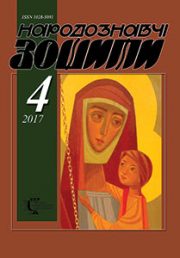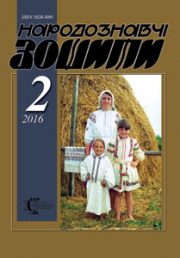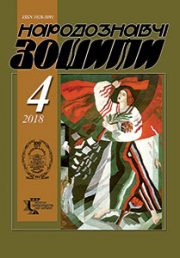The Ethnology Notebooks. 2019, № 6 (150), 1432—1446
UDK[75.04.03’02:27-526.62]:7.046.3
DOI https://doi.org/10.15407/nz2019.06.1432
THE GENESIS OF THE CRUCIFIX IN THE EARLY CHRISTIAN PERIOD
MAKOYDA Orest
ORCID ID: https://orcid.org/0000-0001-6915-2481
Candidate of Art (Ph. D), Senior Researcher
Art Department,
Ethnology Institute of NAS of Ukraine,
15, Svobody ave., 79000, Lviv, Ukraine
e-mail: orestmakoyda@gmail.com
Abstract. Introduction. In the Ukrainian icon painting depiction of crucifix is outlined by a deep philosophical meaning. Crucifix is the most important symbol of Christianity that reveals essence of the Gospel. It has a deep genesis as well as a developed iconography. Each period created its own art concept of this image presentation, with specific symbolism and different stylistic characteristics.
Problem Statement. In the art history until recent times there was a widespread opinion that the image of crucifix was absent in the Christian art as long as execution on a cross existed. Only from the V century, after such execution had been abolished, the first depictions of Christ’s suffering emerged. It is noteworthy, that at the beginning they were of a conditional nature. Nowadays followers of a different theory appear in the scientific circle. They suggest that the first depictions of crucifix could be found in I—III centuries. Recently found artifacts could serve as an evidence of it. To answer this question we tried to study genesis of the crucifix depiction from the most ancient Christian times (of the catacomb period) until Byzantine art emergence.
Results. The genesis of the Crucifix in the early Christian period and the peculiarities of its interpretation have been discussed. The time when the first relics, monuments and statues appeared has been analyzed. The state and conditions of these mementos, as well as their location have been investigated. Symbolic images of Crucifixion on the surface of catacombs, sarcophagus and small plastic pieces have been analyzed. An analysis of the 4 th century images, schemes and patterns of Crucifixion on engraved gems, and some of the most prominent monuments of the early Christian era has been given. Emphasis has been placed on the specifics of the subject of Crucifixion, as well as its interpretation, where Jesus is presented not suffering but in triumph. The theological and ideological principles of torture on the cross and its interpretation in the early period have been outlined, as well as the stylistic directions of the works where this theme was incarnated.
Conclusion. Based on studied material we lean towards a theory expressed by the French scientist of Ukrainian descent Andre Grabar. It says that crucifix went through a complicated and peculiar process of formation in the first years of Christian art incipience. Not only new findings serve as support to this statement, but also the fact of constant development and advancement of this dramatic and deeply symbolic Christian image.
Keywords: Crucifix, early Christian, catacomb, sarcophagus, engraved gem.
Received 7.11.2019
REFERENCES
Monestier, M. (2008). Death Penalty. The history and types of capital punishment from the beginning of time to the present day. Translation from french (P. 292). Moskva: Publishing House Fluid [in Russian].
Lubker, F. (2007). The Real Dictionary of Classical Antiquities, trans. with him. Moskva: Edition on CD-ROM; DirectMedia Publishing [in Russian].
Connolly, P. (2000). Greece and Rome. Encyclopedia of military history. Greece and Rome at War. Moskva: EKSMO-Press [in Russian].
Verry, J. (2009). The wars of antiquity from the Greco-Persian wars to the fall of Rome. Moskva: Eksmo [in Russian].
Pokrovsky, N.V. (2001). The gospel in the monuments of iconography. Moskva: Progress-Tradition [in Russian].
Zaraisky, V. Two landmark discoveries. Retrieved from: http://www.pravmir.ru/article_1161.html.
Andrй, Grabar. (2009). The ways of creation in Christian Ikonography: Antiquity and the Middle Ages. Flammarion. Paris, 1979, 1994. In Andre Grabar. The Origin of Christian Iconography « Initiative». Lviv [in Ukrainian].
Gnutova, S.V. (2007). «The Constantine Cross» — the oldest monument of early Christian art in Russia. Museum readings. Proceedings of the Scientific Conference «Jewelry Art — A Look Through the Ages», december 11—13 (P. 50—65). Kyiv [in Russian].
Uvarov, A.S. (1908). Christian symbolism (Part 1). Symbols of the ancient Christian period. Moskva [in Russian].
Bobrov, Yu.G. (1995). The basics of iconography of old Russian painting. St. Petersburg: Mithril [in Russian].
Zandler, E. (1987). Genesis and theology of the icon. Symbol. Paris [in Russian].
Sabashnikova, E. (Ed.). (1998). History of world art (Pp. 138—139). Moscow: Bertelsmann Media Moskau AO. [in Russian].
The Glory of Byzantium. Art and Culture of the Middle Byzantine Era A.D. 843—1261. Edited be Helen C. Evans and William D. Wixom. The Metropolitan Museum of Art (Pp. 68—69). New York. Distributed by Harry N. Abrams, Inc.; New York.
Getashvili, N.V. (2010). Atlas of world painting. Moskva: OLMA Media Group [in Russian].
Allyson Everingham Sheckler and Mary Joan Winn Leith. (2010, jan.). The Crucifixion Conundrum and Santa Sabina Doors. The Harvard Theological Review, 1 (Vol. 103).
Vatican: Spe Salvi. Chapter 4. «Jesus was not Spartacus, he was not engaged in a fight for political liberation like Barabbas or Bar-Kochba».
Lazarev, V.N. (1986). History of Byzantine painting: in 2 vols. Moskva: Art [in Russian].







